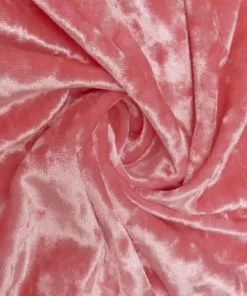Weft Knit fabrics are textiles made by interlocking loops of yarn, creating a flexible and stretchy material, produced in circular knitting machines. Also, another type of knitting is warp knitting, which is produced using a warp knitting machine, Tricot knit, Milanese knit, Simplex knit, and Raschel knit. Weft knit fabrics are popular for their comfort and versatility. There are several types of knit fabrics, each with its unique characteristics, pros, and cons.
For deep reading go to the post “Types of Knitting and Knitted Fabrics”
Types of Knitting
Basically, there are two main types
1. Weft knit
- Jersey knit
- Interlock knit
- Rib-knit
- French terry
- Ponte knit
- Sweater knit
- Single jersey
- Pique knit
- Hacci Knit
- Velour
2. Warp knit
- Tricot knit
- Milanese knit
- Simplex knit
- Raschel knit
- Ketten Raschel knit
- Crochet knit
- Weft-insertion warp
Here are some basic types and their attributes for weft knitting.
Jersey knit
Characteristics: Jersey fabric is lightweight, soft, and comfortable with a smooth, flat surface on one side and textured loops on the other.
Pros: Drapes well, has great elasticity, and is easy to sew.
Cons: Can be prone to pilling and may lose shape over time.
Interlock knit
Characteristics: Interlock fabric is similar to jersey knit but thicker and more stable due to its double-knit construction.
Pros: Good stretch and recovery, less prone to wrinkling.
Cons: May be a bit heavy for some projects, and less breathable compared to single-knit fabrics.
Rib-knit
Characteristics: Rib fabric is vertical ridges on both sides of the fabric, created by alternating knit and purl stitches.
Pros: Excellent stretch and recovery, great for cuffs and collars.
Cons: Can curl at the edges and may not be as smooth as jersey knits.
French terry
Characteristics: french terry fabric is a looped texture on one side and a flat surface on the other, usually made with cotton or a cotton blend.
Pros: Soft, absorbent, and provides good warmth without being too heavy.
Cons: May not be as stretchy as some other knits, and the looped side can snag easily.
Ponte knit
Characteristics: Ponte fabric is a stable and slightly thicker double-knit fabric, often made with a combination of rayon, nylon, and spandex.
Pros: Holds its shape well, resists wrinkles, and offers good stretch.
Cons: May be less breathable than lighter knits.
Sweater knit fabric
Characteristics: sweater knit pattern varies widely depending on the type but is generally designed for making sweaters.
Pros: Can have beautiful textures and designs, ideal for colder weather.
Cons: Some types may require special care during washing and are more prone to snags.
Single jersey knit fabric
Characteristics: A single jersey is used for making sportswear, activewear, and casual clothing
Pros: Similar to jersey knit but with a smoother surface on one side and a looped texture on the other. Stretchable, quick production, and versatile and also more suitable for dying and printing due to smooth surface
Cons: More attractive for early pilling when poor strength yarn is used, curling at edges due to its thinness in structure, and more prone to snagging.
Pique knit fabric
Characteristics: Pique knit fabric characterized by a waffle-like texture. Commonly used for polo shirts and sportswear
Pros: Offers good breathability, moisture wicking, durability and wrinkle resistance
Cons: Limited drape, less stretch, heavier weight, and more potential snagging
Hacci Knit
Characteristics: Hacci fabric is an open-knit construction with a soft, brushed surface, commonly used for lightweight sweaters, cardigans, tops, and loungewear.
Pros: Lightweight and comfortable, soft, cozy and warm, and comfortable stretch.
Cons: Due to the brushed texture, the Hacci knit can be prone to pilling, low stretch recovery, and limited breathability.
Velour knit fabric
Characteristics: Velour fabric is a plush, velvety surface on one side. Velour knit, also known as “velvet knit” or “velour fabric,” is a luxurious and plush type of knit fabric that resembles velvet. It has a soft and velvety surface, making it a popular choice for creating elegant and comfortable clothing items. Used in dresses, tops, skirts, loungewear, tracksuits, and eveningwear. and accessories, adding a touch of luxury to any outfit
Pros: Luxurious and soft to the touch, warmth, Velour knit has a rich and lustrous appearance, giving garments a sophisticated and high-end look,
Cons: Velour fabric is heavier in weight and limited breathability which is not suitable for lightweight warmth countries.
Pros of Knit Fabrics in General
Comfort: Knit fabrics are soft, stretchy, and comfortable to wear.
Stretch and Flexibility: They offer excellent stretch and recovery, providing freedom of movement.
Wrinkle Resistance: Many knit fabrics resist wrinkling, making them easy to care for.
Sewing Ease: Knit fabrics are often forgiving and easier to sew than woven fabrics.
Breathability: Knit fabrics are more breathable in general than some woven fabrics since they have more open spaces between the yarn loops.
Drape: Knit fabrics often have a good drape, meaning they hang and conform to the body’s shape in a flattering manner.
Varieties: Knit fabrics come in various weights and textures, ranging from lightweight and sheer to heavy and dense. Some common types of knit fabrics include jersey, interlock, rib knit, French terry, and sweater knit
Quick Production: Knitted fabrics can be produced relatively quickly process using automated/basic knitting machines, making them more cost-effective and readily available for mass production.
Cons of Knit Fabrics in General
Pilling: Some knits, especially those with synthetic fibers, can develop pills with wear and washing.
Fraying: The edges of some knit fabrics can curl or fray, requiring special attention during sewing.
Shape Retention: Some knits may lose their shape over time, particularly if not cared for properly.
Limited Structure: Knitted fabrics may lack the structured appearance and formality of some woven fabrics, which are not suitable for certain types of formal or tailored garments.






